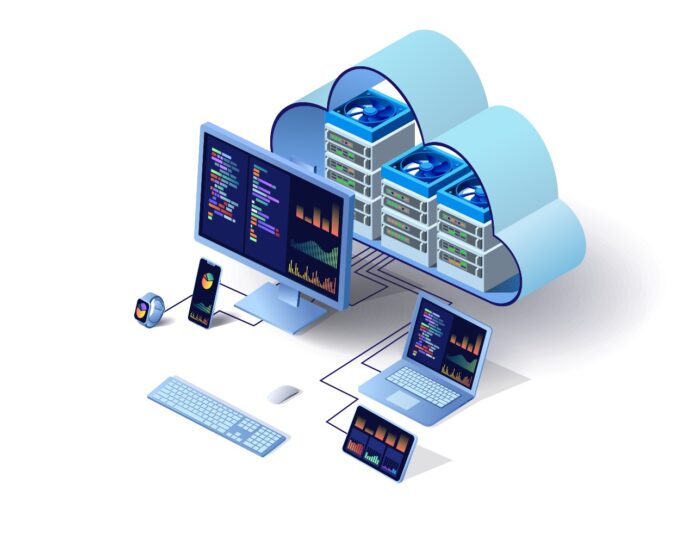Cloud computing is unquestionably gaining in popularity these days. A recent analysis shows that the cloud computing industry is estimated to grow at over 15% compound annual growth rate (CAGR) from 2022 to 2028.
In addition, a report predicted that over 50% of global businesses and enterprises will rely on at least one cloud platform to drive digital transformation and ensure a positive customer experience.
With more businesses migrating to the cloud, maybe you’ve thought about making the transition, too. You may have questions about the process, especially where to start. In this article, you’ll learn the steps to make a smooth transition to the cloud.
-
Gather Organization Buy-In
Migration to the cloud becomes easier and less stressful when all stakeholders are on board. In general, the people you need to get on board first are your technical staff, who’ll set up and manage the cloud infrastructure. Upper management should also be included to support the process.
Meanwhile, employees should have a basic understanding of why the company is moving to the cloud. Since they’ll be your end users, your employees should learn how cloud computing will impact their daily tasks, how it will benefit them, and how there will be a learning curve.
Also, business leaders and managers should prepare clear answers to potential questions before embarking on a cloud transition.
-
Understand And Decide On Your Preferred Cloud Service
Given the huge variety of cloud services available today, you should immediately identify which one you plan to use. Otherwise, you’ll end up running more types of services than you can efficiently manage at once. Hence, you won’t figure out which cloud services are the best fit for your company’s workload.
In general, cloud services fall into three categories:
- Public Cloud
A public cloud is often the first choice of most businesses starting in cloud migration. This is because it’s the least expensive way to get the availability and scalability of the cloud. However, as its name implies, a public cloud means you’re sharing your resources with other users.
On the other hand, you and the cloud provider will share responsibilities for security, with the provider mainly responsible for the underlying hardware.
- Private Cloud
From its name, a private cloud means that only you can use the hardware resources, giving you more control. It provides the scalability and availability of cloud computing but isolates your computing resources and data from other cloud customers.
Nevertheless, a private cloud comes at a higher cost since it provides a dedicated service for your business.
- Hybrid Cloud
A hybrid cloud means that certain parts of your business resources are deployed in the cloud. It can either be on the public or private cloud, or both, while others remain on premises.
Large enterprises often opt for a hybrid cloud to gain more control. They can keep the more sensitive components of their operations on-premises while deploying the rest of their resources online to ensure convenience and accessibility.
Overall, the right cloud service will depend on your company’s needs. Thus, you want to consider several factors, such as how easy or hard it is to deploy data, cost, how it will be managed and monitored, and more. If in doubt, getting professional advice makes a lot of sense.

-
Determine Potential Security Risks
The cloud can be a lifesaver in terms of convenience, accessibility, and scalability. However, it also presents specific security challenges. Since cloud infrastructures are deployed over the internet, it’s easier for attackers to locate and exploit cloud assets.
Furthermore, cloud infrastructures are complex. Even the smallest misconfigurations that allow access to sensitive assets can have huge security implications. Therefore, when planning for your cloud transition, you should assess potential cloud security risks and the necessary steps to mitigate them.
-
Understanding Costs
Transitioning to the cloud will require financial investment on your part. And cloud cost models can change dramatically. While cloud computing allows a business to pay as it goes and simplify cost management, you still need to consider minor costs related to cloud migration.
For instance, a cloud provider may charge egress fees when you move data out of the cloud infrastructure Also, you may have to pay fees for using the provider’s security and monitoring tools.
Thus, it’s essential to perform a detailed assessment and understand how much each type of cloud service, including its tools and resources, will cost you. Then, make some plans on how to control these costs.
-
Define Roles
You should clearly identify and delegate responsibility for your company’s cloud infrastructure to certain individuals. Who will manage your cloud resources? How will changes to the cloud be documented? Will your entire company share one cloud infrastructure, or will each department have its own account?
By answering these questions, you can develop a plan and strategy to manage your cloud infrastructure responsibly. On the other hand, most companies would delegate this task to their IT department, or you can also outsource an IT support provider. However, you must ensure that your IT team has substantial experience and knowledge in managing cloud services.
-
Migrate And Review
Once you’ve developed a cloud migration strategy from the above steps, it’s time to finally transition to the cloud. This means moving your applications, data, and company files onto the cloud servers.
To make this process easier, you can try using an effective data integration tool. This tool can help you with all aspects of migration—from data security to compatibility—helping you successfully migrate your business resources.
Once you’ve migrated to the cloud, it’s important to constantly review your strategies. Cloud services are highly flexible and scalable. Hence, it allows your business to change its processes and try new things to ensure that your business meets its objectives and goals.
Takeaway
Outdated legacy managed systems can restrict your business’s growth. With the right modernization strategy, which includes cloud migration, you can transform your organization and keep up with the ever-evolving digital landscape.
While every cloud transition is unique, the above guide should provide a basic outline on smoothly migrating your resources and assets to the cloud, contributing to your business’s success.





